(Note – this posting has been updated from the original posting on August 5th to reflect new numbers from the CDC and recent incidences involving pesticide applications).
The reports locally-transmitted cases of Zika virus on the mainland U.S. (in south Florida) has had the media and the public in a frenzy and raising concern about spending time outdoors, personal protection, and the need to control mosquitoes.
As of August 31st 2016, the CDC has reported 2,717 confirmed case of Zika virus in the U.S. New York was #1 with 625 cases (23% of the total) but these were all travel-related (not acquired in the U.S.). Florida ranked #2 with 507 travel-related cases (19% of the total) and has the distinction of being the only state to date with locally acquired mosquito-transmitted cases of Zika virus (30 cases). North Carolina remained at #13 with 48 travel-related cases, but zero cases of locally-transmitted Zika virus. Pennsylvania has the only recorded accidental laboratory exposure. Compare these stats with the Commonwealth of Puerto Rico which has over 13,791 locally-transmitted cases of Zika virus.
Florida has intensified its efforts to manage the Zika problem by implementing both ground and aerial spraying and South Carolina recently had an incident involving a massive bee kill (an estimated 3 million bees in 43 colonies) during aerial spraying intended to reduce populations of Aedes aegypti, which the media and public refer to as the “Zika-carrying mosquito”. It’s worth noting that Aedes aegypti has not been found in North Carolina for years, although there is an active survey program underway to see if it has resurfaced.
At this point, our focus should remain on reducing mosquito populations helps reduce both the nuisance biting aspect as well as the risk of exposure to other mosquito-borne diseases. All of the attention has been on Zika, but we also have “resident” diseases such as West Nile virus (WNV), eastern equine encephalitis (EEE) and LaCrosse encephalitis (LAC) which show up in relatively low numbers in our state nearly every year. This fact is not intended to send people into a panic either. In the ten year period of 2003-2012, NC had 6 human cases of EEE and 43 cases of WNV, and 187 cases of LAC which points to a low likelihood of a problem occurring. On July 2nd of this year, the NCDA&CS reported the first fatal case of EEE in a horse in Pitt County (eastern NC). With the recent rains and still several more weeks to our long hot summer, we’re likely to see additional cases in horses and possibly some human cases as well.
It’s important to understand the difference between these diseases and Zika virus. The reason that WNV, EEE, and LACV are more likely to occur here is that those viruses are found in local reservoirs including wild bird populations (such as robins and crows) and some rodents. That shouldn’t be cause for alarm or concern about seeing birds in your yard. The only way for a person (or horse) to get one of these diseases is by being bitten by a mosquito that had first found and fed on an infected bird (which explains why the diseases are not extremely common here). More importantly, a mosquito cannot pick up enough virus from biting a sick person (or horse) and to be able to transfer to another person. Zika virus presents a different situation. So far, it.has only been found in humans. So, a mosquito has to bite an infected person within a few days after that person becomes ill in order for it to pick up the virus and then transfer it later when it bites someone else. Since the cases of Zika virus in North Carolina have (to date) are people who became infected while outside the U.S., the likelihood of them being bitten by a mosquito within the early days of the infection (when the virus is replicating) is extremely low. So, just as when we talk about ticks and tick-borne diseases, getting bit by a mosquito does not mean you need to run to a doctor and “get tested” for one of the viral diseases. Most people infected with EEE don’t exhibit any symptoms. With West Nile virus, .

Make sure window screens fit properly to exclude mosquitoes. (Photo – M. Waldvogel, NCSU)
Integrated Mosquito Management
When used properly, pesticides are an important component of a mosquito control program. However, we can actually have a far greater long-term impact on mosquito populations when we use an integrated mosquito management approach which starts with some simple and common sense tactics, such as keeping mosquitoes out of our homes and businesses. Although this sounds easy enough for those of us who have air conditioning and can keep our homes closed up tightly, there are many people who do not have air conditioning and must keep their windows and doors open and rely on fans to circulate some fresh (and hopefully cooler) air throughout their house. In those situations, keeping window and door screens in good condition and fitting properly is critical to keeping out mosquitoes.
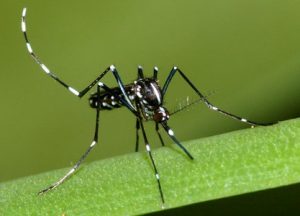
Asian tiger mosquito (photo – Susan Ellis (www.bugwood.org)
Although we have about 65 species of mosquitoes in North Carolina, our primary “mosquito of interest” is the Asian tiger mosquito (ATM), Aedes albopictus (see here). The primary “vector” or transmitted of Zika virus is the “yellow fever mosquito”, Aedes aegypti, which has not been found in recent surveys in North Carolina (but could possibly show up at some point). Back to our main culprit – Asian tiger mosquito likes to feed during the daytime when we’re out working and/or playing, but it will feed “dawn to dusk”. If we really want to put a dent in the mosquito populations around our homes and communities, then we need to focus on the fancy-sounding concept of source reduction. What that simply means is we need to get out in our yards and community and find ways to disrupt or (preferably) eliminate the many mosquito breeding sites that that can be around our homes and are likely due to our own activities (or inactivities!). Asian tiger mosquito does not breed in lakes or ponds (it may be found in pockets of water along the fringes of lakes or ponds). It prefers to lay its eggs in temporary resources – objects/areas that fill with debris and water (or will fill with water). The debris is a food source for the hatching larvae (immature mosquitoes) and as the water slowly stagnates, it attracts more female mosquitoes. The eggs are very durable and can survive cold winter temperature as well as periods of drought. It may actually take several periods of flooding and drying in these areas before all of the mosquito eggs hatch. However, when eggs hatch, a new generation of mosquitoes can be produced in two weeks.
An unpublished study in the 1980s led by Dr. Charles Apperson (Entomology professor emeritus at NCSU) looked at potential Asian tiger mosquito breeding sites found in typical residential settings down in the Wilmington area. Here’s what they found:
| Containers used as breeding sites by Aedes albopictus |
| Source |
No. Positive |
Total Examined |
Percent |
| Misc. containers |
92 |
148 |
62.2% |
| Buckets |
24 |
39 |
61.5% |
| Plant dishes |
33 |
48 |
68.8% |
| Tree holes |
7 |
8 |
85.5% |
| Plastic film (tarps) |
8 |
11 |
72.7% |
| Bird baths |
8 |
27 |
29.6% |
| Tires |
11 |
20 |
55.0% |
| Toys |
8 |
14 |
57.1% |
Quite obviously – in the war against the Asian tiger mosquito, we are often our own worst enemy. If we are serious about wanting to reduce mosquito populations and reduce the likelihood of mosquito-borne diseases, then we need to focus our attention on a community-wide effort to “tip and toss” these mosquito breeding sites:
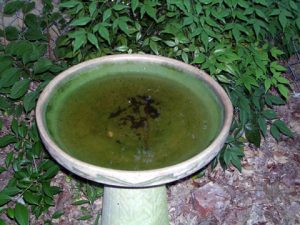
Bird bath with stagnant water. (Photo – M. Waldvogel, NCSU)
Bird baths – clean them out periodically and flush them out routinely with a garden hose. You’ll flush out the mosquito larvae in the process. Plus, the birds will appreciate the fresh water. Do the same with the outdoor water bowls for your pets. Horse (and livestock) owners that have water troughs near stalls or out in pastures can also use products such as “Mosquito Dunks®” which contain the bacteria Bacillus thuringiensis israelensis which kill mosquito larvae (but not adult mosquitoes) and a few fly species while not posing a hazard to the animals that use the troughs as their drinking water.
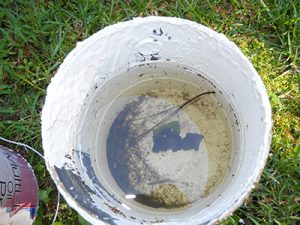
Asian tiger mosquito larvae in a paint can filled with debris and rainwater. (Photo – M. Waldvogel, NCSU)
Cans and other containers – now is the time to empty them and dispose of them properly at your municipal recycling center (if suitable) or at a designated landfill. Improperly/illegally discarded items such as cans, appliances, tires, etc. can become a serious problem in terms of mosquitoes.

Swimming pool tarp filled with rainwater, debris and mosquito larvae ( (Photo – M. Waldvogel, NCSU)
Plastic tarps that cover your boat, pool, grill, firewood, etc. can collect pockets of water that can remain for several weeks.
Swimming pools and kids’ wading pools that are not used or maintained are probably being used by the mosquitoes (and maybe some toads) – empty and overturn them (and make sure that the pool water drains from the area). This same problems can occur with poorly maintained in-ground and large above-ground pools (e.g., pools on abandoned or foreclosed properties). Here’s a picture of a poorly-maintained tarp-covered swimming pool that is collecting stagnant water filled with algae, dead leaves and Asian tiger mosquito larvae.
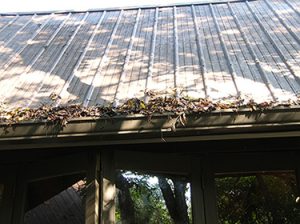
Keep your gutters free of debris so rainwater drains properly. (Photo – M. Waldvogel, NCSU)
Gutters – Remove all of the leaves and other debris that build up in your gutters. Although the leaves on the top may seem dry, the water and wet decaying material trapped underneath this layer attract mosquitoes and can also lead to structural problems with wood-decay in the roof and fascia boards and create conditions conducive to problems with wood-damaging pests such as termites and carpenter ants.
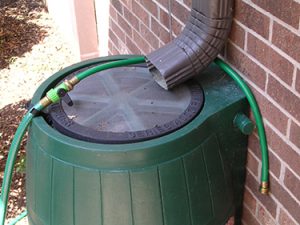
Keep rain barrels screened to exclude debris and mosquitoes. (Photo – M. Waldvogel, NCSU)
Rain barrels – They’re a great way to conserve water resources by collecting rainwater from your roof’s downspouts. However, they can also unintentionally become a great way to raise mosquitoes. The commercial versions of these barrels are equipped with screens that keep out trash and keep mosquitoes from laying eggs inside. If you decide to make your own rainwater collector by using an old barrel, then you be sure to place ordinary window screening over the top.
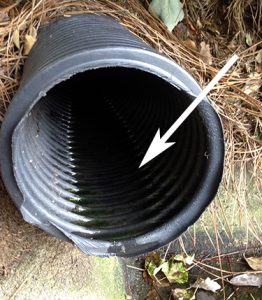
Make sure drain pipe tilt down and drain away from your home. (Photo – M. Waldvogel, NCSU)
Downspout drain pipes – The concept is simple – channel rainwater so that it drains away from your house (and doesn’t pool up against your foundation). Also, if you install those black plastic drainage pipes to the downspout, remember this thing called “gravity”. I don’t mean the movie. Water isn’t going to flow uphill on its own. Make sure the pipe is placed properly so that the water drains out and away and water doesn’t pond in one spot near your house. Here’s a picture of a plastic pipe behind a restaurant in Raleigh where even a slight upturn in the pipe causes water to pool and stagnate inside it and so it becomes an Asian tiger mosquito habitat and dines in the dining patrons.. (My thanks to Randy Buchanan with the Henrico Co. (VA) DPWEES Standing Water Initiative for mentioning this common problem to me).
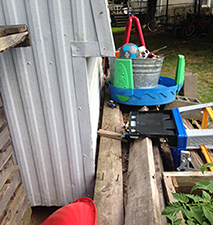
Clutter in this yard collects and holds storm water & debris which attracts mosquitoes
Trash, trash cans and tires – Simple equation: Clutter + Rain = Mosquitoes.. Make sure trash cans have tight-fitting lids which will also keep out pests such as rats and raccoon which can damage trash bags creating more problems. Discard or at least cover old tires (but don’t let water pool in the plastic cover either!). If you use tires to make a swing for your kids, be sure to drill holes through the bottom of the tires so rain water drains out quickly.
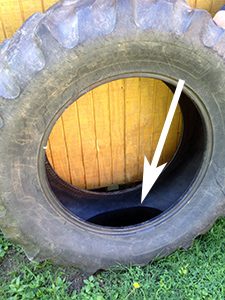
Even the small about of trapped rainwater in this tire can support hundreds of mosquito larvae (Photo – M. Waldvogel, NCSU)
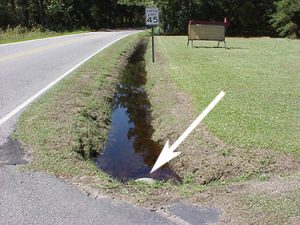
Stormwater run-off and debris in drainage ditches become mosquito breeding grounds. (Photo – M. Waldvogel, NCSU)
Drainage ditches – they’re meant to collect storm water that runs off roads and and yards temporarily. Over time, they also collect soil and debris from storms, erosion and mowing. Keep them free of debris so that water flows and has time to filter into the soil. In the picture to the right from Hurricane Fran (1996), storm and other debris had created a dam at the end of the culvert running under the driveway (arrow) which caused the ditch to become mosquito-infested in just a matter of days
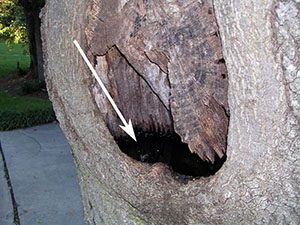
Tree holes created by damaged limbs collect water and debris for mosquito breeding (Photo – M. Waldvogel, NCSU)
Tree holes – when limbs fall off trees, the remaining hole in the trunk can collect water. Flush out the tree hole and fill the hole with expandable foam (not concrete).
Outdoor flower pots – empty the water from the dishes/trays underneath them. Your plants have plenty of water without the overflow. Overwatering plants can also lead to problems with root rot and fungus gnats infesting the plant soil.
Mosquito Traps
There are a number of traps available at retail stores and online. Some of these use special chemicals that mimic odors that attract mosquitoes. The traps will catch lots of mosquitoes if placed properly but using them to “control” mosquitoes is unlikely to succeed.
Personal Protection
The majority of mosquito-borne disease incidences, whether they’re human or otherwise, are due to a lack of personal protection. Horse owners need to spend the time and money to get their horses vaccinated against mosquito-borne diseases. The Veterinary Division of the NC Department of Agriculture & Consumer Services has advice on protecting horses from eastern equine encephalitis and other diseases. For us two-legged creatures, we simply need to take precautions when we’re outdoors for work or recreation. If it’s too uncomfortable to wear long-sleeved shirts and long pants, then apply insect repellent to your clothing and/or exposed areas of your skin (never apply these repellents under clothing). We recommend using products registered with the EPA rather than using home-remedies or “web legends” (such as the dryer sheets) that rely on anecdotes rather than actual scientific data to back up their effectiveness. OSHA has developed some guidelines for workers who work outdoors where they are more likely to encounter mosquitoes (and potentially Zika virus in affected areas).
DEET is the most commonly used repellent and has a proven track record as a repellent. Some people prefer alternative products which repel mosquitoes but a few of those may have shorter time for which they are effective as compared to DEET. . Consumer Reports did a review of insect repellents to help people decide on which product to use. Selecting a repellent becomes a matter of common sense – choose a product that fits your needs and your preferences. Most importantly, READ THE PRODUCT LABEL and follow the recommendations for how often to apply it. So, if you prefer a non-DEET product that has a short period of effectiveness, then it’s simply a matter of applying it more frequently (but not over-applying it). Use repellents carefully, particularly on young children. Some repellents are not intended for infants and products with reduced concentrations are often recommended for children under the age of 12 years old. Never allow children to apply repellents to themselves or to other children. Spray the chemical on your hands and rub it onto their legs, arms and neck (not on their hands where it can end up in their eyes and mouth). For infants, mosquito netting placed over a stroller is an excellent choice.
For more information on mosquito repellents, visit these sites:
Chemical Control
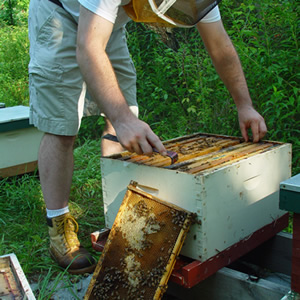
Before you spray any pesticide, “bee” aware of bees and other pollinators in your yard and surrounding properties.
There are many products available if you decide to treat your property to kill adult mosquitoes. Please keep in mind that chemical doesn’t always land where you direct your spray particularly under windy conditions and it can end up on someone else’s property. Look before you spray and communicate with your neighbors. Not everyone wants pesticide drifting into their yard. Make sure you know what’s on the other side of your shrubs. Read the pesticide label before you spray. Never treat where children or pets are found (and don’t let them return to the area until the chemical has dried on surfaces). Many products contain insecticides that cannot be applied to edible plants. So, it is important to be very careful when spraying near vegetable & herb gardens or fruiting trees. Even if your your herb garden is for decorative purposes only, you never know when a neighbor or even visiting wildlife may decide to “borrow” a few sprigs.
Many (most) of the insecticide products commonly used against mosquitoes are “pyrethroids” which are toxic to bees (not just honey bees) and other pollinators and beneficial insects (such as lady beetles). The product labels have restrictions on applying them to flowering plants or else restrict their use to times when pollinators are not actively visiting flowers. If your neighbor has bee hives in his/her backyard, you should talk to them first and make sure chemical doesn’t drift into their backyard (and onto their plants and/or bee hives) and possibly harm the bees.
Most pyrethroid insecticides have “common names” that end in “thrin”. The common name is not the brand name (like “Mike’s Bug Destroyer”). The common name is found under the “Active Ingredients” section of the label. People who are thinking about having their yard sprayed (or their neighbor is having their yard sprayed) have called me asking about these pesticides because they’ve been told by the company that they’re using “the same chemical found in chrysanthemums”. That statement is true if the company is actually using pyrethrum or “pyrethrins” but is NOT accurate if they’re applying something like bifenthrin or permethrin which are synthetic and chemically altered versions of the pyrethrin molecules (“pyrethroids”). My advice is that before you have your yard treated by anyone, always ask to see copies of the product’s label and its safety data sheet (formerly called the “MSDS”) so that you know exactly what will be applied and if it’s being applied according to directions which reduce the risk of exposure for you and the “good bugs”.
There are other products that target mosquito breeding sites and the mosquito larvae& pupae living in them. Some products contain a bacteria called Bacilllus thuringensis israelensis or “BTi” which is sold under several trade names including “Mosquito Dunks” and “BioBit”. The bacteria is related to but is not the same BT that many people use in their gardens to kill cabbageworms and cutworms. BTi only affects mosquitoes and a few other fly species (such as fungus gnats and midges). An advantage of these products is that they do not affect beneficial insects or fish or even livestock that might drink out of water troughs in a pasture (which can also become home to mosquitoes if the water becomes stagnant).
These biological pesticides have an important long-term impact on mosquito populations, but it’s important to remember two things: First, these chemicals are not a substitute for eliminating mosquito breeding sites wherever possible. Second, they will not eliminate the mosquitoes we see flying around today (or even the next few days). BTI only affects the mosquito larvae, not the pupae in the water or the adults that are already flying around and so the effect the bacteria will be most noticeable in about 10-14 days IF you take the time to eliminate as many breeding sites as possible.
Natural Control of Mosquitoes
Not everyone shares my love of bats (the fur-covered flying mammals, not the wooden ones used to hit baseballs). Some people put up bat boxes in their yards hoping to attract bats to eat the mosquitoes. While bats do eat mosquitoes, they are “generalists” which simply means they also eat a lot of other flying insects as well. More importantly, keep in mind that public enemy mosquito #1 in most cases is the Asian tiger mosquito which is active during the day whereas bats are active at dusk/night. There are birds (such as purple martins) that also eat mosquitoes but they too have a diverse diet. So, support our local birds and bats but don’t count on them to solver your mosquito problem.
Mosquito fish (also called Gambusia) have also become more popular for natural control of mosquitoes. These small “guppy-like” fish are famous for their consumption of mosquito larvae and pupae (the stage right before the adult). They will also eat other aquatic insects as well as young fish and amphibians. They have some problems with cold weather and may die out (requiring that you restock the pond). We also have many native fish that will also put a dent in a pond’s mosquito population. Because of this fish’s ability to out-compete native species, releasing Gambusia should be limited to closed ponds that do open to public waters. Also, remember that Asian tiger mosquitoes mostly breed in artificial objects and temporary water sources and so mosquito fish are not likely to control a backyard (or community) mosquito problem.
FINALLY – remember that mosquitoes have no concept of property lines. Even though species such as the Asian tiger mosquito typically fly just short distances (usually less than 100 yards), the object of the female’s attention is a blood meal whether it’s in your neighbor’s yard or your yard. Mosquito management does work BUT it requires a concerted community effort to be truly effective. You’ve heard the expression “It takes a village”. With mosquitoes, it takes just one uncooperative “village idiot” to make your collective efforts fail.
We have more information on mosquito control at http://insects.ncsu.edu/Urban/mosquito.htm.
Note:
Any recommendations for the use of chemicals are included solely as a convenience to the reader. They do not imply that insecticides are necessarily the sole or most appropriate method of control. Any mention of brand names does not imply endorsements by me or by North Carolina Cooperative Extension or NC State University nor does it imply that the product is superior to others Individuals who use chemicals are responsible for using these products according to the regulations in their state and to the guidelines on the product label. What that really means in plain language is simply don’t be an idiot when you use pesticides. Before applying any chemical, read the product label carefully and follow the instructions for mixing and applying.
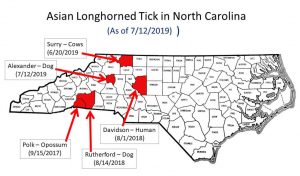



 The problems that follow disasters such as Hurricane Matthew with loss of electricity and water, as well as damage to our homes, schools and workplace, bring a variety of unwanted pest problems as well. The extent of these problems depends in part the seasonal cycle of pest activity. Visit our
The problems that follow disasters such as Hurricane Matthew with loss of electricity and water, as well as damage to our homes, schools and workplace, bring a variety of unwanted pest problems as well. The extent of these problems depends in part the seasonal cycle of pest activity. Visit our 











